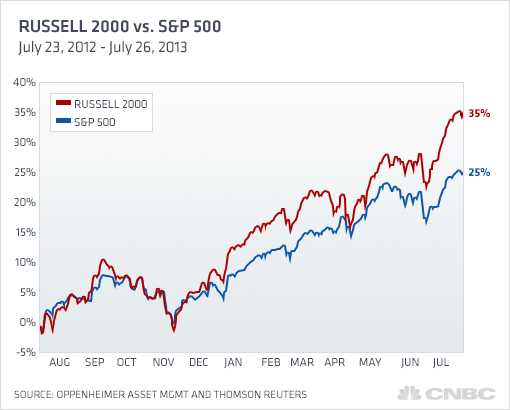"The Russell is now as extreme as ever, and I'm bearish for months and it keeps going up every day," he said. "People treat the strength as a sign it's getting better. I just think it's more dangerous."
Worth says the performance of the Russell 2000 relative to the S&P 500 is now at a maximum. The Russell was 25 percent above the top of 2007 and 2011—around 850, and at 1,050 was approaching its internal trend line.
"It's not that its outperformed, the others have lagged," he said. Worth said the Russell 2000 has left fundamentals behind, with a P/E multiple close to 30 percent.
(Read more: A busy week for the markets with Fed, GDP and jobs report)
He said while investors have been racing to the Russell to avoid the negative impacts of Europe and China by going into companies with mostly U.S. earnings, they are leaving behind some of the safer spots in the market—mega-cap names like Microsoft. Worth also is betting on beaten down Apple to outperform the S&P 500.
The Russell has also jumped well above its 150-day moving average. "When it has reached similar extremes in the past, returns have been asymmetrical," notes Worth. "There was little upside and plenty of downside."
(Read more: The rally has gone too far—strategist)
The Russell last week reached a high of 1,056, 12 percent above its 150-day moving average. Worth said going back over 15 years, whenever the index traded as much as 12 percent above trend, a meaningful correction was in the offing.
Paul LaRosa, technical strategist at Maxim Group, says he doesn't see a sign the Russell is topping yet, though he says a pullback would be routine. "A normal correction would be down to 1,010," he said.
(Read more: Strategist raises target on S&P 500)
"It seems like you want to take a little breather. That's what I'm feeling, but that would be acceptable. That's fine. If [the S&P 500] stays between 1,671 and 1,698, that's your zone and you're going to know whether you're heading higher or lower, when you get a close above or below those levels," he said.
The iShares Russell 2000 ETF flashed a caution sign last Wednesday, said Scott Redler of T3live.com, who follows the market's short-term technical moves. He said it broke the recent ascending channel to the downside, but then found buyers at the eight-day moving average of $103.30 and showed some resilience Thursday. The iShares Russell 2000 ETF continued to hang around the mid-$103 level Monday afternoon.
The Russell was midrange in afternoon trading Monday, after hitting 1,038 on the downside and 1,048 on the upside.
"It's a very tricky spot right in here. You don't want to have shorts on the brain but you don't want to be caught in a sneaky down move like we just saw in Japan," said Redler. He said the Nikkei's quick drop is worth monitoring since it's been leading other markets.
Last week, the market was sending some bearish signals but the reversal Friday afternoon from a 150-point Dow loss put pressure on shorts. Redler said on Monday, some of the high–beta names, like Apple were doing well.
Read More: Small caps pose latest threat to rally
"There's no reason to be excessively long. I think there's a little frustration on both sides," he said. "I'm long Apple but short SPY" (SPDR S&P 500 ETF).
Redler also does not think the Russell is toppy but it could pull back. "A rest is good, but I wouldn't overdramatize that. But it is acting a little weaker than it has in the past few weeks since it broke out," he said.
—By CNBC's Patti Domm. Read More of her posts on Marketinisider.cnbc.com and follow her on twitter @pattidomm.




